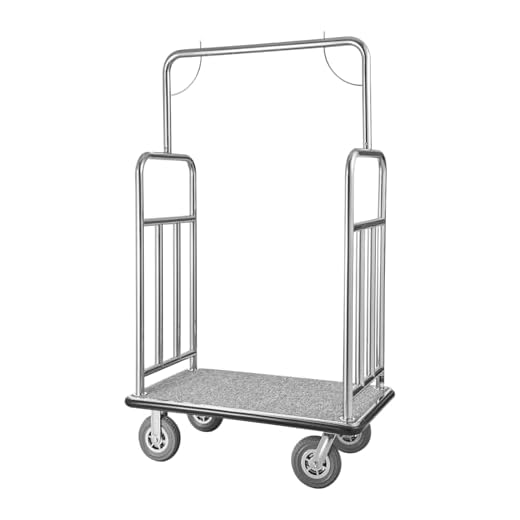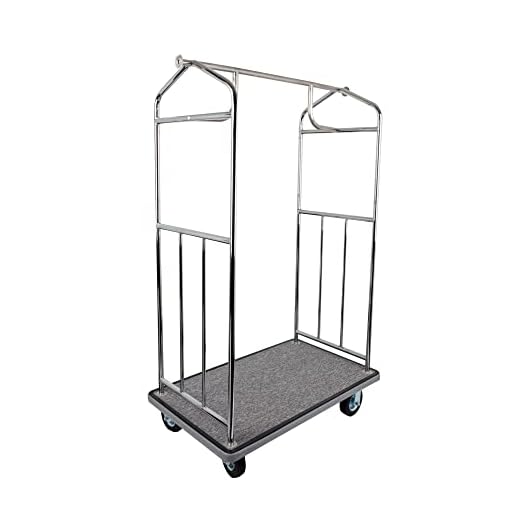






Prefer personal roller suitcases or collapsible trolleys for trips between terminals; large, terminal-issued carrier platforms often obstruct doorways and may be declined at boarding.
Operational notes: The automated people mover is free inside the terminal loop; exiting at Jamaica or Howard Beach to connect with the Long Island Rail Road or New York City Subway requires an $8.25 access charge at fare gates. Port Authority staff expect carriage that does not block aisles, doorways or designated wheelchair spaces; hazardous materials and oversized commercial platforms are prohibited on public rail vehicles and may be restricted by connecting carriers.
Practical recommendations: fold or consolidate large items before approaching the platform, position bags in vestibule zones without blocking traffic, use elevators where available for level changes, and request ramp or porter assistance at curbside if handling more than two heavy pieces. If transferring to LIRR or subway, move belongings to smaller cases – those vehicles have narrower doorways and limited standing room. Typical porter tipping is $2–5 per bag.
Policy for terminal trolleys on the rail connector at John F. Kennedy International Airport
Transfer baggage from full-size terminal trolleys onto a compact dolly or rolling suitcase prior to boarding the airport rail connector to prevent aisle blockage and to speed platform and elevator moves.
- Recommended dimensions: collapsible dollies under 24 in (61 cm) wide and stack height below 40 in (102 cm) to fit car vestibules and doorway clearances.
- Suggested maximum single-load weight: roughly 50 lb (23 kg) per hand truck; redistribute heavier loads into checked bags or request porter assistance.
- Use elevators at terminal–rail interfaces; elevators are available at all terminal connections and at the Jamaica and Howard Beach station transfers for step-free access.
- Airport-owned coin-operated trolleys are intended for terminal circulation; transferring contents into compact carriers before passing fare gates reduces congestion and door jams.
- During peak windows (approx. 07:00–09:00 and 16:00–18:00 local), wait for less crowded service or board via wide-door entrances; place the dolly in the vestibule and secure loose items to prevent shifting.
- All carried items remain subject to TSA and Port Authority screening; keep passports, phones, and valuables on person or in a locked carry bag.
- Porter and mobility assistance available at curbside and customer service desks–use these services for oversized, heavy, or awkward loads.
Quick checklist
- Empty terminal trolley into a compact dolly or suitcase.
- Confirm width ≤24 in (61 cm) and height ≤40 in (102 cm).
- Keep per-dolly weight ≈50 lb (23 kg) or request porter.
- Use elevators, avoid peak windows, and secure items in the vestibule area.
People-mover policy at John F. Kennedy International Airport – personal wheeled carriers onboard?
Recommendation: Non-motorized, foldable personal wheeled carriers that are stowed without obstructing doors, aisles or vestibules are permitted on the airport people-mover; powered units with lithium batteries above common airline thresholds are typically restricted unless certified as medical mobility devices.
Size and stowage guidance: If a collapsible carrier reduces to approximate carry-on dimensions (about 22 × 14 × 9 inches / 56 × 36 × 23 cm), treat it as standard baggage and place it in end vestibules or on provided racks. Rigid platform trolleys or oversized hand trucks that protrude into walkways may be refused during peak hours.
Battery and motor rules: Battery-powered hauling devices with lithium-ion cells over 100 Wh normally require prior approval from the Port Authority or the airline; sealed lead-acid batteries and non-powered models pose fewer restrictions. Medical mobility devices powered by batteries are accepted but advance notification is recommended to avoid delays.
Enforcement and alternatives: Station staff enforce stowage and safety rules; individuals with commercial-style hand trucks are often directed to curbside baggage services or checked handling. Airport-provided rolling baggage carts are available curbside and at terminals for heavier loads.
Practical tips: Fold the unit before entering the platform, board through vestibule doors to minimize obstruction, secure items in end compartments, and avoid peak-period boarding with bulky wheeled gear. For an unrelated compact-accessory resource, see best air stone for fish tank.
Airport-issued baggage trolleys: pickup, drop-off points and fees for automated people mover riders
Pick up airport-issued baggage trolleys at terminal curbside kiosks, arrivals baggage-claim islands, selected parking-garage entrances and inside ticketing lobbies; typical practice requires a refundable deposit collected by card or coin, with returns processed at designated bays before the automated people mover platform.
Pickup locations and access
Typical pickup points: curbside kiosks adjacent to departure curb, baggage-claim level near conveyor belts, arrival-hall islands, garage entry points and vendor stands inside each terminal. Payment options at kiosks usually include credit/debit cards, coins and contactless payments on newer units. Airline assistance desks can arrange free trolley use for passengers with mobility needs.
Drop-off points, fees and refund procedure
Designated drop-off points: baggage claim return lanes, curbside return kiosks outside each terminal, rental-car shuttle islands and the entry area immediately preceding the automated people mover platform. Fee structure commonly follows a refundable-deposit model (typical range $3–$6; $5 most frequent); failure to return results in a retained deposit charged as a nonrefundable fee. Refund processing: sensor-equipped return slots credit the original card within 3–10 business days; older coin-based models dispense coins instantly. For disputes or lost-receipt refunds, contact the vendor listed on the trolley or visit the airport lost-and-found/vendor service counter.
Allow a few extra minutes when transferring to the automated people mover to return a trolley at the nearest bay; pack a compact umbrella for wet transfers – see best studry umbrella for preschoolers.
Transfer rules and practical limits at Jamaica and Howard Beach
Use accessible fare gates and station elevators for any wheeled baggage trolley wider than about 24 in (61 cm); standard waist‑high turnstiles at MTA paid areas are roughly 22–24 in (56–61 cm) clear and will not pass wider rigs.
Gate widths, elevator and platform constraints
Standard metro turnstiles: approx. 22–24 in (56–61 cm) clear. Accessible (wide) gates: roughly 32–36 in (81–91 cm) clear; those are located at main entrances, elevator landings and staffed booths at both Jamaica and Howard Beach. Typical station elevators range from about 36×48 in to 60×42 in (91×122 cm to 152×107 cm) – fold handles and orient wheeled rig lengthwise to maximize clearance. LIRR high‑level platforms at Jamaica have small horizontal gaps and a single step up into most cars; board through marked accessible doors or the car designated for mobility assistance when bulky bags or large trolleys are present.
Quick operational advice
Measure total width including handle and any protrusions; collapse handles to get under ~24 in for standard gates. Avoid escalators with wheeled rigs; use elevators or ask station staff to open the wide gate. If gear exceeds accessible gate width, move to street level and use an accessible entrance or request assistance from LIRR/NYC Transit staff–allow extra time for assistance and possible re‑entry procedures. During peak periods choose the LIRR/NYCT car positions marked for accessibility to minimize platform gap and boarding difficulty.
Practical handling: using elevators, escalators and tight platforms with a baggage trolley
Use elevators for loaded trolleys when combined mass exceeds 35 kg (75 lb) or when the carrier footprint exceeds 30 × 20 inches; reserve escalators for empty or very-light wheeled suitcases and single-bag dollies.
Elevator handling
Enter with the trolley handle toward the car wall, parallel to the door; this minimizes swing when doors open. Leave a 12–18 inch buffer between the trolley and the doorway sensors to prevent accidental closing. If the trolley has no parking brake, place one wheel against the cab wall and stand behind the handle with one foot braced; keep both hands on the handle while doors move. For grouped transfers, load heaviest items first and distribute weight longitudinally so center of gravity stays well inside the car. Public-elevator door clearances typically range 32–36 inches; if the carrier width approaches that, request the next elevator or assistance rather than forcing entry.
Secure loose straps and small items before entering to avoid snagging. If available, press the door-close button only after confirming no mobility device or wheelchair is approaching; never block a door with the trolley. For loads over ~70 kg (155 lb) or awkward shapes, use two-person lifts or a platform dolly instead of attempting a single-person maneuver.
Escalators and tight platform boarding
Avoid escalators with wheeled carriers whenever possible. If a transfer must use an escalator with a compact, low-profile case, keep the carrier’s wheels squarely on a single step, face forward, and hold the handrail with one hand while stabilizing the handle with the other; step off immediately and smoothly at the top. Do not attempt escalator use with multi-wheeled trolleys, heavy stacked baggage, or items that shift easily.
At narrow platforms, align the trolley parallel to the platform edge and stop at least 24–36 inches from the edge while waiting for doors to open. Approach a vehicle door using short, controlled pushes; when thresholds are higher than wheel diameter, tip the trolley back slightly (10–20°) to lift wheels over the lip rather than forcing forward. Keep the load centered and, if possible, have one person stabilize from inside the vehicle while another pushes from the platform. Always give priority space to other passengers boarding and to mobility devices; if clearance is tight, request assistance rather than attempting a risky squeeze.







